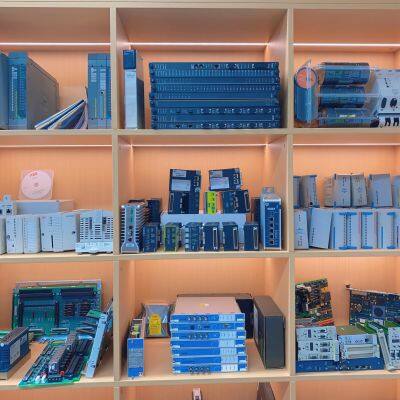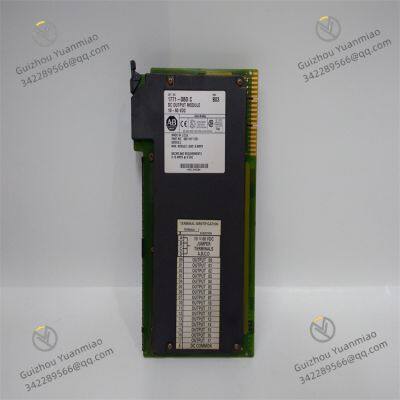Product Description
I. Product Overview
The Allen-Bradley 1771-OBD module is a 16-channel non-isolated DC digital output module, specially designed for the control of DC-powered equipment in industrial automation systems. In industrial production, many DC load devices, such as indicator lights, relay coils, solenoid valves, and various DC drive devices, the precise control of their operating status plays a key role in the smooth progress of the production process. The 1771-OBD module can accurately receive digital control commands sent by the PLC controller, convert them into corresponding DC output signals, and reliably drive external DC load devices, ensuring the automation and efficiency of the industrial production process.
The module adopts a compact and standardized design, which can perfectly fit with the 1771 series I/O enclosures. Except for the 1771-A4 I/O enclosure, it can be easily installed in various models of I/O enclosures from 1771-A1B to 1771-A4B, providing users with a flexible system construction scheme. The module shell is made of high-quality industrial-grade plastic material, which has good impact resistance and vibration resistance, and can effectively deal with vibration interference in environments such as mechanical processing workshops and automated production lines. At the same time, the shell has certain dust-proof and moisture-proof properties, and can operate stably under complex industrial working conditions such as dust and humidity, ensuring long-term and reliable output control.

II. Performance Parameters
(1) Electrical Characteristics
Power Requirement: The 1771-OBD module obtains working power through the backplane of the 1771 I/O enclosure. The requirement for the backplane power supply is +5V DC, and the typical current consumption during operation is 400mA. This kind of enclosure backplane power supply mode avoids the trouble of configuring a separate power supply for the module, and at the same time ensures the consistency and stability of the power supply between the module and other modules in the enclosure.
Number of Output Points: It has 16 DC digital output channels, which can control 16 DC load devices at the same time, meeting the needs of small and medium-sized industrial control systems for multi-device DC control. If more devices need to be controlled, the system can be easily expanded by increasing the number of modules.
Output Signal Type: The output signal is a DC signal, with a wide output voltage range of 10V DC to 60V DC, which can adapt to a variety of DC load devices with different rated voltages. Its nominal output voltage is 48V DC, which can effectively drive common DC loads.
Output Current: The rated current of each output channel is 2A (resistive load), and the total output current of the module does not exceed 8A. For inductive loads such as control relays, each output channel can withstand a current of 0.2A. When dealing with the current impact at the moment of startup, each output channel can withstand a current of 4A for 10ms, and can be repeated every 2 seconds; in special cases, it can also withstand a current of 25A for 10ms, also repeated every 2 seconds. This excellent overload capacity ensures the stable operation of the module under complex load conditions.
Switching Frequency: The output channel has a fast switching response speed. The switching time from off to on is 0.1ms, and from on to off is 0.2ms, which can meet the requirements of fast response for equipment start-stop control in most industrial production scenarios, and realize precise control of the production process.
(2) Interface Characteristics
External Load Interface: Equipped with a standard screw terminal block for connecting external DC load devices. This connection method is firm and reliable, effectively avoiding loose wiring caused by vibration, collision and other factors, and ensuring the stability of signal transmission and the reliability of load driving. The terminals of each output channel and the common terminal are clearly marked on the terminal block, so that technicians can quickly and accurately complete the wiring work according to the marks.

Backplane Communication Interface: With the help of the backplane connector of the 1771 I/O enclosure, the module realizes efficient communication with the PLC processor. Through this interface, the module can timely receive the control commands issued by the PLC controller and quickly convert them into corresponding DC output signals to accurately control external devices. The backplane interface adopts a reliable electrical connection design, which ensures the timeliness and accuracy of control command transmission, enables the module to quickly respond to the control requirements of the PLC, and improves the operating efficiency of the entire control system.
(3) Environmental Adaptability
Operating Temperature: It can operate stably in the temperature range of 0°C to 60°C, and can adapt to common temperature changes in industrial production workshops. Whether it is hot summer or cold winter, it will not affect its output control performance and working stability, ensuring that the production process is not disturbed by temperature fluctuations.
Storage Temperature: In the storage state, the module can withstand extreme temperatures from -40°C to 85°C, ensuring that internal components will not be damaged even in harsh temperature conditions during transportation and long-term storage, providing a guarantee for the long-term availability of the module.
Anti-Electromagnetic Interference: It meets industrial-grade electromagnetic compatibility standards and has strong anti-electromagnetic interference capabilities. In industrial sites, equipment such as motors, transformers, and electric welders will generate a lot of electromagnetic interference. The 1771-OBD module can effectively resist these interferences, prevent output signals from malfunctioning due to interference, ensure the accuracy of control over external DC equipment, and improve the reliability of system operation.

III. Functional Characteristics
(1) Precise DC Output Control
The core function of the 1771-OBD module is to accurately convert the digital control signals (0 and 1) output by the PLC controller into corresponding DC output signals, so as to realize reliable control of external DC load devices. When receiving the "1" command from the PLC, the corresponding output channel is turned on, and the DC voltage is output to drive the load device to work; when receiving the "0" command, the output channel is turned off, and the load device stops running. Whether it is long-term stable output control or frequent equipment start-stop operations, the module can stably and reliably execute control tasks, providing a solid guarantee for the control of DC equipment in industrial automated production. For example, in an automated assembly line, the start and stop of DC motors can be precisely controlled through this module to realize accurate conveying and positioning of materials.
(2) Intuitive Status Indication
The module is equipped with intuitive status indicators, including a power indicator and status indicators for each output point. The power indicator being on indicates that the module is powered normally; each output point corresponds to a status indicator. When the output point is in the on state, the indicator is on. Technicians can quickly and intuitively understand the working status of the module, whether each output channel is on, and whether the external load device responds normally by observing the status of the indicators, which greatly improves the efficiency of system debugging and troubleshooting.
(3) Comprehensive Protection Functions
The module has certain overload and short-circuit protection functions. When the load connected to the output channel is overloaded or short-circuited, the module can quickly detect the abnormality and automatically cut off the output of that channel, preventing internal components of the module from being damaged due to overcurrent, and avoiding the spread of faults to other channels, ensuring the normal operation of other output channels. After the fault is eliminated, the module can automatically resume normal operation, effectively improving the reliability and service life of the module, and reducing the risk of system failures caused by abnormal loads.
(4) Excellent Compatibility and Expandability
The 1771-OBD module has excellent compatibility with Allen-Bradley's PLC-5 series controllers, and can be directly connected to the PLC system without complex configuration and debugging processes. In addition, in the 1771 I/O enclosure, it can be mixed with other types of modules such as digital input modules and analog modules, which is convenient for users to build a complete and flexible industrial automation control system according to actual needs. When the production scale expands or the number of controlled devices increases, users can easily expand the number of output points by increasing the number of 1771-OBD modules, improving the control capability and flexibility of the system.
Allen-Bradley 1771-OBDS Current Limiting Digital Output Module
Allen-Bradley 1771-OBN Digital DC Output Module
Allen-Bradley 1771-OFE2 Analog Output Module
Allen-Bradley 1771-OJ Pulse Output Expander Module
Allen-Bradley 1771-OM AC Output Module
Allen-Bradley 1771-OWN Digital I/O Relay Contact Output Module


Allen-Bradley 1771-P2 Power Supply Module
Allen-Bradley 1771-P7 Power Supply Module
Allen-Bradley 1771-P4S Power Supply Module
Allen-Bradley 1771-VHSC Very High-Speed Counter Module
GE IS200TDBSH2ACC Terminal Base Module
GE IS230TNDSH2A Terminal Base Module
GE SR745-W2-P1-G1-HI-A-L-R-E Transformer Protection System
Schneider TM251MESE Logic Controller
Schneider TM3AQ4 Output Module
Schneider TM3AI8 Analog Input Expansion Module
DEIF DLQ144-PC-NB Multi-Function Controller
VANGUARD PSMU-350-3 CPCI-350Q-P-38 Power Supply
 yezi
Hi there! Welcome to my shop. Let me know if you have any questions.
yezi
Hi there! Welcome to my shop. Let me know if you have any questions.





